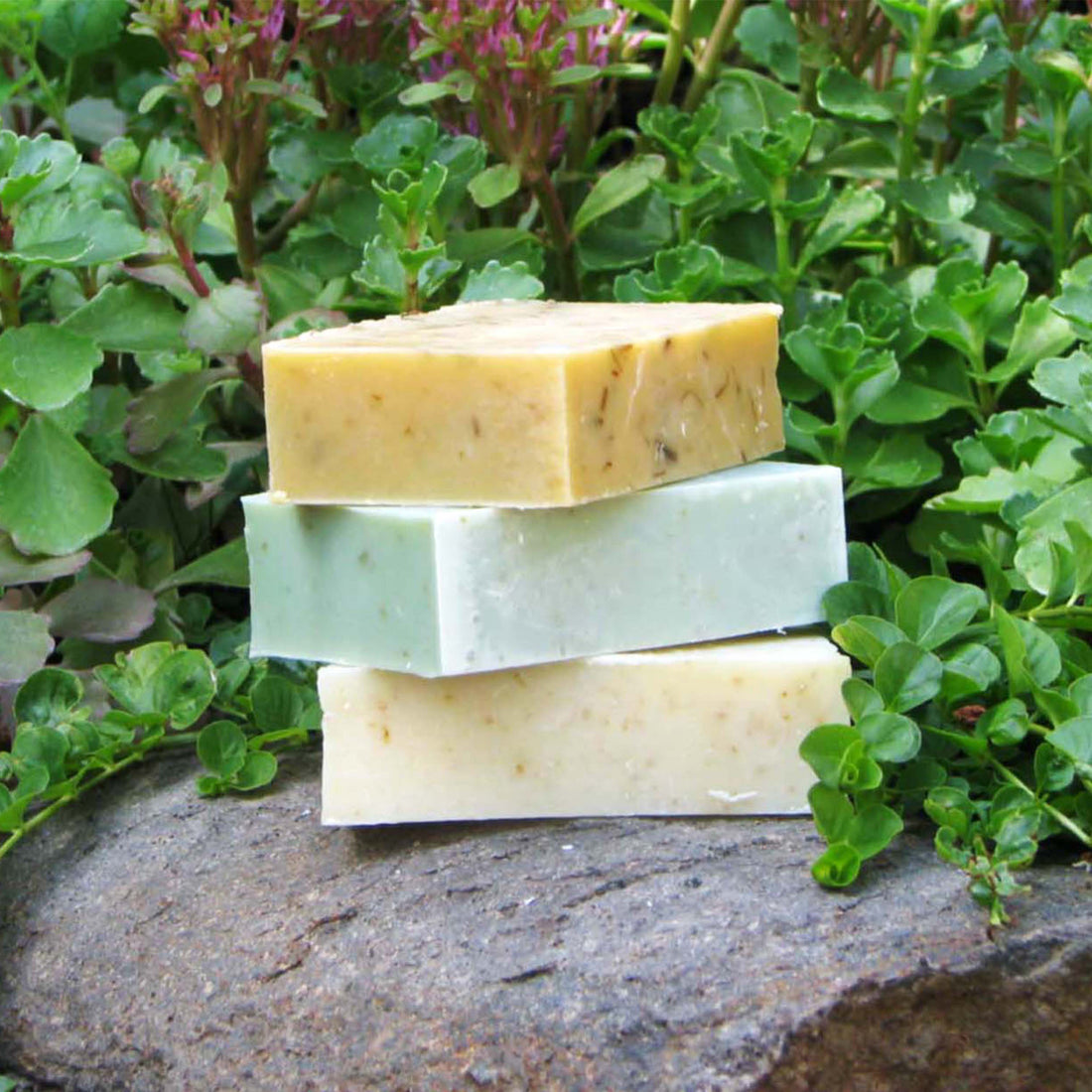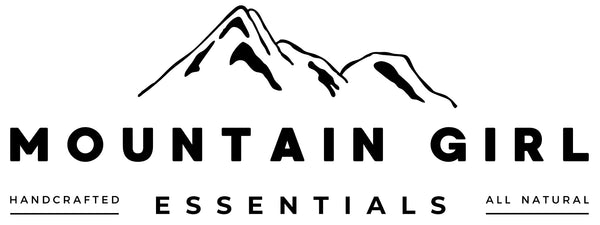
Guide to Handmade Soap
Share
Handmade Soap – Nearly Everything You Need To Know
Bar Soap is making a comeback. Read up on what real soap is and why everyone is in a lather about its return.
The very first all-natural bar soap I made was not very pretty. It was a drab-gray, earthy rectangular chunk of oatmeal and tallow soap that changed my skin forever. I’ve been obligated a time or two since then to use so-called luxury hotel soap when I’ve forgotten to pack my Mountain Girl Soap, and instantly regretted the itchy, dry, tight skin that followed using detergent bars. I’ve gotten so used to the way my soap makes my skin look, feel and smell. Here’s why handmade soap is a better choice for your skin.
HOW SOAP IS MADE
Soap itself does not occur in nature; but it can be handcrafted through an artisanal process. In this way it is similar to artisan-made bread, wine, craft beer, cheese, hand-blown glass, or hand-thrown pottery.
Soap is made by combining fats or oils with an alkali (sodium or potassium hydroxide, lye, NaOH). The alkali splits the fats or oils into two components: fatty acids and glycerin. Then, the sodium part of the alkali joins with the fatty acid part of the fat or oils in a super cool chemical process called saponification. This combination is the alkali salt of a fatty acid or real soap. As a bonus, the glycerin remains in the soap as a natural humectant and draws moisture to the skin.
Since 2007, I have been handcrafting genuine soap in the traditional cold processed method using high quality, local ingredients. I control every step of the process including formulation, careful weighing of ingredients, hand stirring, hand pouring and hand cutting. My soap is crafted to moisturize, condition, and promote healthy skin.
pH AND YOUR SKIN
You hear the expression “pH balanced for your skin” all the time. So, what’s the deal? Is this a marketing thing to trick you into buying products or is there more to it?
What is pH? pH is the measure of acidity or alkalinity on a scale of 1 to 14, going from acid (1) to alkaline (14). Our skin is only slightly acidic and has an average pH of 5.5, while the human body has a pH in the range of 7.35-7.45.
What is the acid mantle? The secretions covering our skin are called the acid mantle, a hydro-lipid film that consists of a natural barrier made up of lipids, sebum and sweat. This barrier is designed to protect the skin from bacteria and fungus as well as water loss.
Why be concerned about the pH of a skin care product? Because harsh surfactants in cleansers can damage skin and its barrier. You know the feeling - tightness, dryness, irritation, and itchiness that you get after using commercial detergents. Therefore, the use of "pH balanced" products is thought to be less disturbing to the acid mantle of the skin.
THIS is where handmade soap is different! While handcrafted cold process soap is the alkali salt of a fatty acid (and is therefore alkaline in nature) and it typically measures between 8-10 on the pH scale, it is different. The reason it's different is because opposed to harsh detergents, well-formulated cold process soap is very mild. When "super fatted" it contains “free oil/fatty acid" that replaces some of the moisture and lipids lost while washing dirt away. Furthermore, what’s amazing is that after bathing the skin begins re-secreting the acid mantle immediately and it returns to its normal pH.
Not convinced? Check out this article about a study that compared the pH of the skin between users of a soap-based cleanser and of a mild-acidic cleanser prior to and following the cleansing. Results show the long-term use of soap does not affect the pH-maintenance mechanism of skin.
cold processed soap is the mildest cleanser that you can use on your body
In a nutshell: Well-formulated, super-fatted cold processed soap is the mildest cleanser that you can use on your body. Being alkaline, it will remove some of the skin's dirt bearing oil, but it gently cleanses and doesn't strip the skin but leaves behind moisturizing oils/lipids/fatty acids.
Still unsure? The best and most accurate test of a good mild soap is how it feels on your skin. You be the judge. Try my soap bars and see if they don't leave your skin feeling soft, supple, smooth and moisturized.
QUESTION OF THE DAY: SHOULD I USE ANTIBACTERIAL SOAP?
In these days of COVID-19 it seems like people are more obsessed with cleanliness, sterilizing and disinfecting than ever before.
On September 2, 2016 the FDA published a consumer update stating that "there isn’t enough science to show that over-the-counter (OTC) antibacterial soaps are better at preventing illness than washing with plain soap and water. In addition, the wide use of these products over a long time has raised the question of potential negative effects on your health."
Triclosan can be found in many consumer products today. "Because of that, people’s long-term exposure to triclosan is higher than previously thought, raising concerns about the potential risks associated with the use of this ingredient over a lifetime."
In addition, laboratory studies have raised the possibility that triclosan contributes to making bacteria resistant to antibiotics. Some data shows this resistance may have a significant impact on the effectiveness of medical treatments.
The FDA's recommendation: "Wash your hands with plain soap and water. That’s still one of the most important steps you can take to avoid getting sick and to prevent spreading germs."

HOW SOAP WORKS
The idea that soap kills germs is actually a misconception. Then how does soap get you clean? In simple terms, soap is a magnet to both water and dirt; it attaches itself to both water and germs. When you lather with soap it attracts the dirt and then when you rinse with water, the soap along with the dirt gets washed away.
The mechanical force—the act of rubbing your hands together under warm water with soap—is what dislodges and cleans away harmful microbes.
This article from the New York Times explains the power of soap. "When you wash your hands with soap and water, you surround any microorganisms on your skin with soap molecules. The hydrophobic tails of the free-floating soap molecules attempt to evade water; in the process, they wedge themselves into the lipid envelopes of certain microbes and viruses, prying them apart... "They act like crowbars and destabilize the whole system,”"
Because of the way soap cleans it’s better than hand sanitizer. Alton Brown’s handwashing video explains it in a perfectly entertaining way. If that’s not your style, check out this tutorial from the Centers for Disease Control and Prevention (CDC).
BUT I’VE HEARD THAT BAR SOAP IS UNHYGIENIC
The real truth is that there are germs on your skin which transfer to your soap during use. See, there are bacteria cells that live on our skin called the microbiome. These microorganisms are essential to our immune system and protects us from pathogens.
So, when you lather with bar soap, you’re basically transferring bacteria from your skin to your soap and back again. It’s very unlikely that anyone would get sick from soap since most of the microorganisms on it came from you.
Still, if you want to minimize the amount of germs on your bar you can follow these suggestions. Lather and rinse the bar before using it on your body. Use a clean washcloth each time (if you use one). Allow your soap bar to dry between uses. If you use a slotted soap holder to drain the water from your soap make sure it’s one made of a nonporous material. Bonus: keeping your bar dry also extends the life of it.
But isn’t liquid soap from a dispenser more hygienic? One thing to consider is the frequency with which the dispenser is cleaned. And how easy is the dispenser pump itself to sanitize? Another consideration is the location of the washing station – if it’s in a kitchen it could be contaminated with hands that handled raw meat – or in a public restroom or environment with a high concentration of bacteria. Would a personal liquid soap dispenser be anymore hygienic than a personal bar of soap? Maybe not. In either case, a bar of soap is very unlikely to make anyone sick.

WHY USE HANDMADE SOAP?
Yeah, I’m partial. I’ve been making and using handmade soap for over 13 years. After all it has many benefits! Here’s a quick rundown on some of the reasons handmade soap is superior:
It’s the real thing. Real soap made from real ingredients, with no harmful stuff.
- Commercial soap sold in stores is not real soap at all; it’s a cocktail of synthetic ingredients: detergents, fragrances, hardeners, and lathering agents that cause allergic reactions, dehydrates and prematurely ages skin, and have been linked to cancer. See this ingredient deck comparison between a popular commercial (detergent) bar and one of my handmade soap bars.
It’s moisturizing. Some of the ingredients typically found in commercial (detergent) bars are drying, irritating and itchy to the skin.
- Handmade soap is made with real, skin-loving oils like olive, avocado and coconut, and butters like shea, cocoa and mango butters
- It also contains naturally occurring glycerin. Glycerin is a humectant that attracts moisture to the skin and is what makes handmade soap so fabulous for the skin!
- It’s super-fatted. This means it contains more moisturizers than actually needed for saponification (soap making process), making it super moisturizing.
It’s gentle. Commercial detergent bars are harsh and strip the skin of its acid mantle and disrupt the function of the barrier. Handmade soap gently cleanses the skin and doesn’t strip the skin.
It’s nourishing. Plant oils are rich in antioxidants, vitamins and nutrients that are essential for healthy skin. Essential oils also nourish the soul, providing a gentle aromatherapy treatment during use.
CONCLUSION
There is a lot more I can say, but hopefully I’ve convinced you enough to be curious. As a soap maker I am thrilled to talk to anyone about the benefits of handmade soap, so if you have questions just hit me up. I stand behind my product and offer a 30-day guarantee if you’re not satisfied. Do your skin a favor and treat it to the simple luxury of handmade soap.
Love and Peace and Happy Skin From Me to You,

